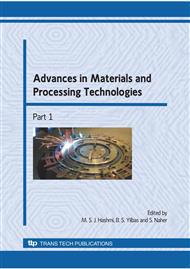p.497
p.505
p.524
p.530
p.537
p.545
p.553
p.563
p.571
Effects of Simulated Pit Distribution Parameters on Tensile Properties of a Structural Steel Plate
Abstract:
Degradation of tensile properties resulting from geometrical discontinuities due to localized pitting is usually evaluated in terms of the reduced section thickness associated with pit geometry which lowers the load carrying capacity of the structure. However, the effects of finer parameters associated with pit distributions such as pit area percent (PAP) are not usually taken into account. In this research, the effects of spacing, depth and PAP on tensile properties of a structural steel are investigated. Simulated pit distributions were produced on the gage sections of flat tensile specimens using mechanical drilling. It is found that final elongation is more adversely affected than tensile strength with increasing PAP, pith depth and pith spacing. However, the reduction in final elongation tends to be largely recovered at higher PAP values due to increasing uniformity of strain distribution. It is noted that increasing pit spacing at a constant PAP leads to greater reductions in tensile properties, especially at higher pit depths, due to the increased stress concentration and strain localization. It is further clarifies that the introduction of first few pits and their growth to larger depths could be very detrimental to the mechanical properties of structural alloys.
Info:
Periodical:
Pages:
537-544
Citation:
Online since:
December 2009
Authors:
Keywords:
Price:
Сopyright:
© 2010 Trans Tech Publications Ltd. All Rights Reserved
Share:
Citation:


